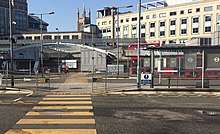Hammersmith bus station
Hammersmith bus station is located adjacent to the District & Piccadilly and Circle and Hammersmith & City lines London Underground stations in Hammersmith. It is owned and maintained by Transport for London.
 The lower bus station in 2012 | |
| Location | Hammersmith London Borough of Hammersmith and Fulham |
| Operated by | Transport for London |
| Bus operators | |
| Connections |
|
The bus station is divided into two sections (lower and upper stations). The routes which serve the lower station, outside Hammersmith Broadway, are 33, 72 (towards Roehampton), 209, 266, 419, 485 and 609. The routes which serve the upper station, above Hammersmith Broadway, are 9, 23, 27, 72 (towards East Acton), 190, 211, 220, 267, 283 (towards East Acton), 295, 391, H91, N9, N11 and N97.[1] The upper station is also served by Berry's Coaches Taunton to London services.[2]
History
Butterwick bus station was replaced by Hammersmith bus station in 1993. Butterwick Bus Station was demolished in late 1992 to make way for the new bus station. Route 667 used to terminate at the bus station and was operated from Fulwell bus garage.[3]
In May 1937, a crowd gathered at Hammersmith bus station to watch the first route 11 bus leave after a strike lasting a month.[4][5]

In 2004, Transport for London was successful in getting planning permission to extend the bus station. The extended bus station would include an information facility, cycle racks, and CCTV coverage. The new bus station's construction began in 2006 and the lower bus station opened in 2008. The road surrounding the new development was changed slightly, with a subway used to cross the road closed down.[6] The extension was opened in February 2008.[7]
In August 2011, Transport for London refurbished the southern end of the bus station. This refurbishment meant routes 9 and 10 had to move stops, and the closed bus stop was converted into a rest area for the bus station's staff.[8]
Crime
In December 2004, an x-ray weapons scanner was introduced for a week at the bus station. The bus station was chosen for the trial because of the high number of disorder reports at the site.[9][10][11]
In September 2006, a dispersal order was introduced to the bus station after gangs meeting at Hammersmith Broadway. In January 2007, the order was extended for another three months.[12][13]
On 16 May 2011, a 14-year-old boy was stabbed at the lower bus station.[14][15]
References
- "Buses from Hammersmith" (PDF). Transport for London. Retrieved 27 July 2017.
- London Superfast Berry's Coaches
- "Old soldier and Whitton character". Richmond & Twickenham Times. 10 December 2004. Retrieved 8 July 2013.
- "London Cheers Return of Public Transportation". Ottawa Citizen. 28 May 1937. Retrieved 8 July 2013.
- "Buses again running in London". The Leader-Post. 29 May 1937. Retrieved 8 July 2013.
- Rooney, Lisa (20 February 2004). "Hammersmith Bus Station gets green light". Transport for London. Retrieved 8 July 2013.
- "Extension to Hammersmith's bus station opens". Transport for London. 12 February 2008. Retrieved 8 July 2013.
- Courtney, Adam (26 August 2011). "Traffic chaos continues as council refuses to budge on roadworks". Get West London. Retrieved 8 July 2014.
- "Bus passengers to be scanned for knives". Evening Standard. 7 December 2004. Retrieved 8 July 2013.
- "Bus passengers scanned for knives". BBC News. 7 December 2004. Retrieved 8 July 2013.
- "Plan for weapons searches in pubs". BBC News. 15 December 2004. Retrieved 8 July 2013.
- "'End of line' for Hammersmith bus station yobs". 24dash. 19 January 2007. Retrieved 8 July 2013.
- "Dispersal order extended to tackle bus station bullies". 24dash. 2 April 2007. Retrieved 8 July 2013.
- Burns, Greg (16 May 2011). "Teenager stabbed at Hammersmith bus station". Fulham Chronicle. Retrieved 8 July 2013.
- Burns, Greg (19 May 2011). "Teens charged over Hammersmith bus station stabbing". Fulham Chronicle. Retrieved 8 July 2013.
External links
| Wikimedia Commons has media related to Hammersmith bus station. |